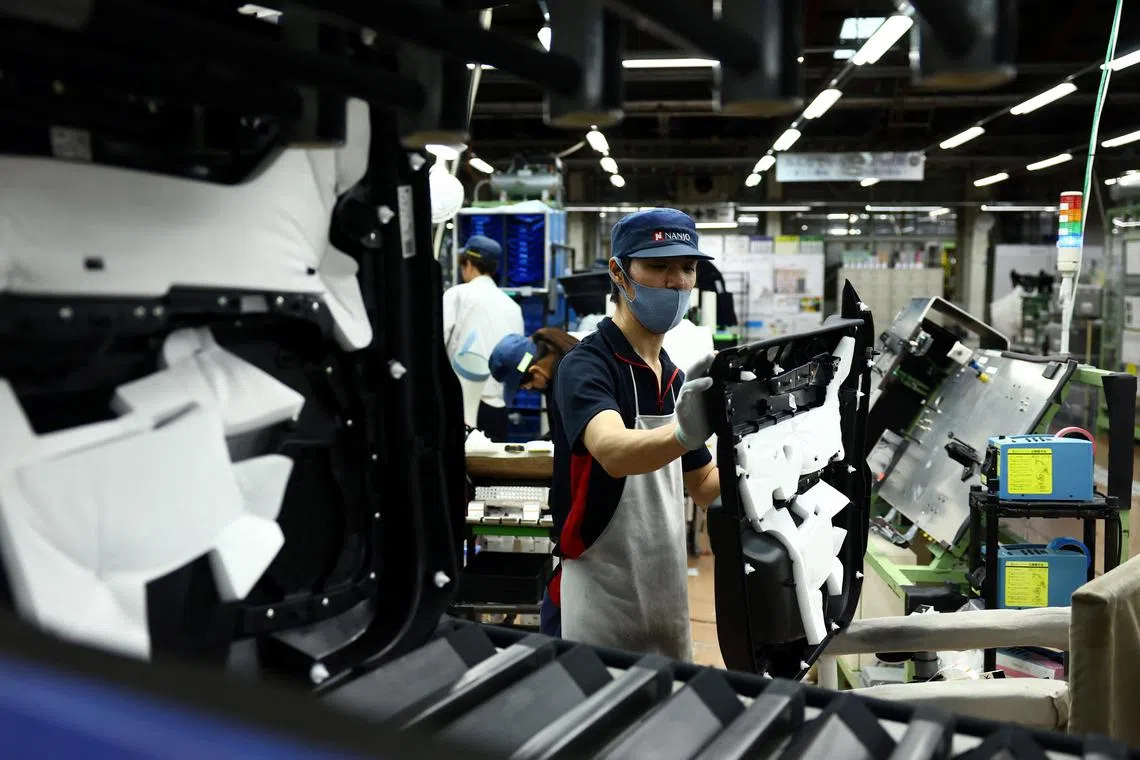Japan voters see little hope for tariff reprieve in carmaker Mazda’s home town
Sign up now: Get ST's newsletters delivered to your inbox

Workers at Nanjo Auto Interior, which makes door panels and other parts for Mazda Motor, in Akitakata, Japan, on July 14.
PHOTO: REUTERS
Follow topic:
HIROSHIMA, Japan – When carmaker Mazda sneezes, everyone catches a cold, say people in its home town of Hiroshima in western Japan, but these days, auto parts maker Yuji Yamaguchi fears a deep chill is on the way.
“If Mazda builds fewer cars, our orders will drop,” said Mr Yamaguchi, whose 110-year-old firm, Nanjo Auto Interior, has almost 1,000 employees making door panels and other parts for the automaker, which accounts for more than 90 per cent of its sales.
“The key thing is whether we can remain profitable with lower volumes.”
The economic engine of Hiroshima, a manufacturing hub 800km south-west of Tokyo, Mazda faces US tariffs of 25 per cent on vehicles, a dispiriting prospect for an electorate already battling inflation and a weak economy.
Japan votes on July 20 in an Upper House election that looks set to weaken the grip on power of Prime Minister Shigeru Ishiba, who has failed to win a tariff reprieve from the United States, its closest ally and a crucial trade partner.
“I have no expectations for the Japanese government any more,” said Mr Yamaguchi, a great-grandson of Mazda founder Jujiro Matsuda. “I’m past frustration and have just resigned myself to things.”
As people in Hiroshima and other auto manufacturing regions brace themselves for the inevitable fallout from tariffs, Mr Yamaguchi said he had little hope the government could turn the tide.
US President Donald Trump has given no sign of relenting on his tariffs,
Mazda, which saw US sales fall 18.6 per cent in May year on year and by 6.5 per cent in June, is one of the Japanese carmakers most exposed to US tariffs.
Imports bring in the bulk of Mazda’s American sales, but the importance of the wider industry for Japan is almost impossible to overstate.
After Japan ceded global leadership in chips and consumer electronics, its auto industry grew to make up about 28 per cent of the roughly US$145 billion (S$186 billion) worth of goods shipped to the US in 2024.
There are more than 68,000 companies in Japan’s auto supply chain, a July survey by research firm Teikoku Databank showed, and the Jama industry group says it employs 5.6 million people, or about 8 per cent of the labour force.
“A supply chain is hard to rebuild once broken,” said Mr Hideki Tsuchikawa, research head at Teikoku Databank’s branch in Hiroshima, which his firm estimates is home to more than 2,000 auto suppliers.
“Automobiles are a core national industry. Government support is essential.”
The tariffs could cost Mazda and other smaller Japanese automakers US market share lost to bigger rivals, said Ms Julie Boote, an auto analyst at Pelham Smithers Associates in London.
Mazda, headquartered in Hiroshima, where it has assembly plants, has so far declined to give a full-year earnings outlook, citing the uncertainty of tariffs.
In a statement, Mazda told Reuters its top priority was to protect suppliers, dealers and employees as it looked to overcome the tariff impact.
It anticipated significant impact in the short term, the company said, adding it was taking all possible steps, such as asking for government countermeasures.
‘No overtime, no drinking’
It is hard to say whether the uncertainty will further deepen voter anger over time, or how much opposition parties will be able to chip away at Mr Ishiba’s support as they look to tap into voter discontent.
For the auto industry there seems to be no recourse except to return to a well-worn playbook of cost-cutting perfected during Japan’s years of stop-start economic growth.
No overtime means no extra money for drinking, said Mr Koji Sasaki, the 54-year-old owner of a bar in the town of Fuchu close to Mazda’s headquarters, where the automaker’s employees usually form the bulk of customers.
Their numbers have dropped in recent months, with some regulars apologising for making fewer visits, he said.
Drinking in Mr Sasaki’s bar on a recent July evening was company veteran Toshiyuki Shimizu, 45, who said Mazda had already cut back on overtime and business travel for employees.
“We used to bring junior staff along on business trips, but now I often go alone,” said Mr Akira Ichigi, a 32-year-old Mazda colleague, adding that the limits denied junior employees valuable experience acquired on such trips.
Mazda has set up a tariff strategy team that would meet each week in Hiroshima, said one company insider, speaking on condition of anonymity.
But Mazda faced constraints in finding ways to tackle the tariffs from a labour shortage in the US, that kept it from boosting capacity at its sole plant there, operated with Toyota, the source added.
Mazda said overtime cuts and a business travel review were part of its drive to cut 100 billion yen (S$8.6 million) in costs. Essential travel continued, but it was evaluating whether accompanying staff were necessary, it said.
The company set up a team to monitor tariffs and was working with suppliers and dealers, it said, adding that key to increasing supply to the US market were its efforts to tackle labour shortages and strengthen the supply chain.
For now, parts supplier Yamaguchi said he was not considering specific steps to counter the tariffs.
“In business, we need to have long-term vision,” he said, likening the moment to the Covid-19 pandemic, when his company posted a loss in 2020 but returned to profit the next year by working to boost efficiency rather than cutting costs.
“If we don’t invest in 2025, we might miss opportunities.” REUTERS

